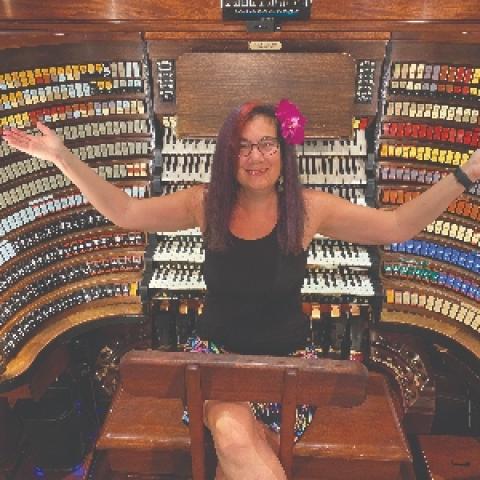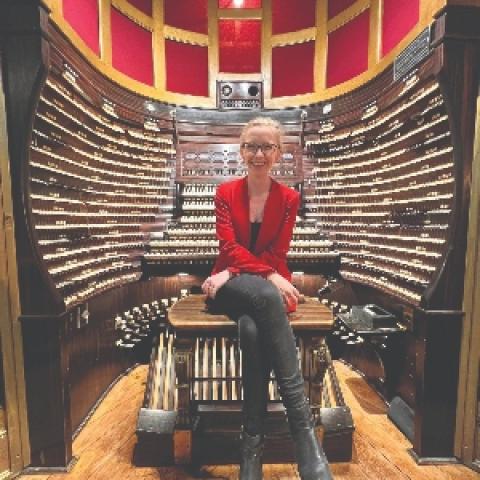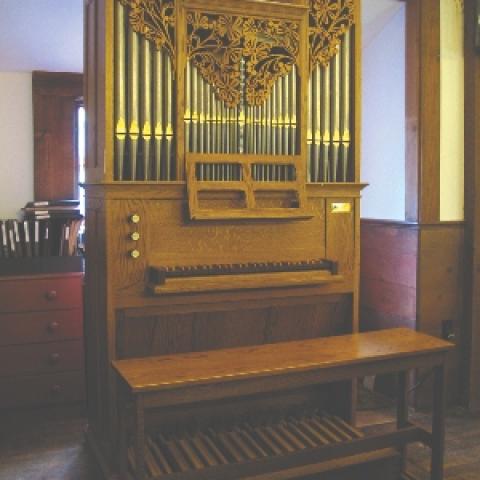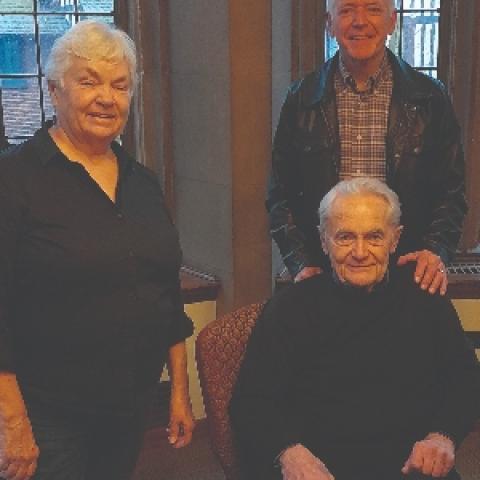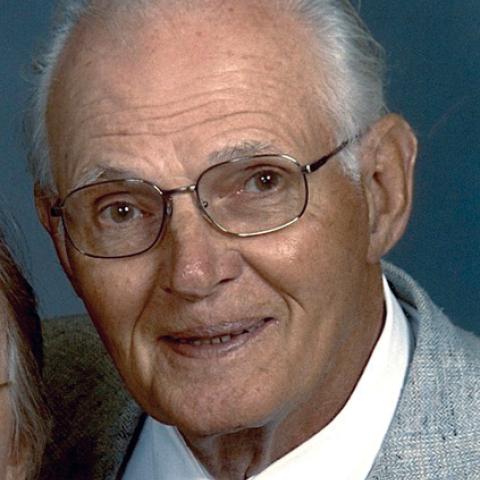
Teachers
Elizabeth Swist was my first piano teacher. I was six years old. She lived with her mother, and their house smelled like boiled cabbages. It was about a mile walk—I know that for sure because I have driven the route watching my odometer a couple times. My lessons included the Hanon piano method and little novelty pieces that I played as loud and fast as I could; spinning wheels were a common theme in the music. My mother likes to tell how I came home from my first lesson, ran to our piano, played middle C and shouted, “I knew it. Middle C on Miss Swist’s (say it three times fast) piano is higher than ours.” Mother says she complained to the tuner, “I just paid $25,” but the tuner said I was right. It was an old second-hand upright, and he had not been able to bring it up to pitch. She tells that story every chance she gets; some of it might be true.
Miss Swist got married and moved into a house a little closer to ours that did not smell like cabbages. Mrs. Holderied, née Swist, helped me out of the beginner’s novelties into real music like Bach minuets and Clementi sonatas.
We moved from Westwood, Massachusetts, to nearby Winchester when I was ten, and I took up lessons with Edith Bolster, an elderly woman who lived in an apartment with two pianos. I do not remember meeting her partner, but I got an occasional glimpse of her lurking about. Ms. Bolster introduced me to Mozart, Beethoven, Mendelssohn, and the expressive qualities of the piano, and she encouraged me to play in recitals arranged by the various local piano teachers.
I was twelve when I had my first organ lessons with Alastair Cassels-Brown at Saint John’s Chapel of the Episcopal Theological School (later Episcopal Divinity School, now defunct) outside Harvard Square in Cambridge, Massachusetts. My father was the professor of homiletics there. The organ was built by Walter Holtkamp, Sr., in 1956, with three manuals including one of the earliest Rückpositiv divisions in the United States. I often rode my bike the eight miles over busy commuting roads through Somerville and Cambridge to get to my lessons. Dr. Cassels-Brown had been associate organist at the Cathedral of Saint John the Divine in New York City during Alec Wyton’s tenure there. He seemed worldly to me and shared insights into the structure of music beyond stringing series of notes together.
I was a middle-schooler when Dr. Cassels-Brown showed me the Fibonacci series, how that sequence of numbers fit into the natural world and governed some of the flowing beauty of music. He also taught me to compare the characteristics of music of a given era between different nationalities—for example, eighteenth-century France and Germany—and how the different styles of composition reflected different types of organ building. He was a gentle, soft-spoken man, and I guess he was a thoughtful, conservative player. Sometimes, he asked me to sit with him during special services, turning pages and witnessing what went into structuring a worship service from an organ console.
After a couple years, Dr. Cassels-Brown recommended I shift to studying with John Skelton, organist of the First Congregational Church in Winchester, just a couple blocks from where we lived. The church had a brand-new, three-manual Fisk organ, and I was fortunate to have generous practice privileges there. Mr. Skelton had studied with Yuko Hayashi at the New England Conservatory and with Anton Heiller in Vienna, and was well connected with the exciting organ scene in Boston in the early 1970s. There were several young “boutique” organ companies in the area rejuvenating the concept of the mechanical-action pipe organ, and John made sure I got to hear recitals and attend workshop open houses, drawing me into that crowd as a young teenager. I remember an after-concert dinner at the Wursthaus (a long-gone favorite haunt of organists in Harvard Square) after an organ recital, at which someone pointed out that there were nine organists present who played for churches that had Fisk organs.
John Skelton understood and nourished my fascination with pipe organ tone, discussing the functions and construction of the various stops and allowing me to register the pieces I was learning. I loved listening to the organ’s voices as I chose them.
The harpsichord builder Carl Fudge was organist of my home church, the Parish of the Epiphany in Winchester, where my father was rector. He led the junior choir, which was where I was first exposed to church music, and as my voice changed, I moved to the senior choir. Carl was supportive of my early studies and took me to organ recitals. I am especially grateful that I heard E. Power Biggs play on the Flentrop organ at the “Museum Formerly Known as Busch-Reisinger.” What a thrill it was to hear him play Charles Ives’s Variations on “America” as an encore following a recital of Baroque music.
Organbuilder George Bozeman was another mentor during my teenage years. His wife Pat sang in the choir at Epiphany, and together they took me around the circuit to concerts, workshops (George worked for the Noack Organ Company at the time), and social events. I worked in George’s new shop, Bozeman-Gibson & Company, during the summers of 1975 and 1976, after my freshman and sophomore years at Oberlin, my first real experiences as a newbie organbuilder.
Burton Cowgill was the music director at Winchester High School where I was put to work accompanying everything and everybody. I bet a lot of readers grew up as workhorse accompanists. As chorus director, Mr. Cowgill led us through a huge amount of sacred music, something that would likely get him in trouble today. The greatest hits of Vivaldi, Pergolesi, and Gabrieli, among others, helped further my interest in that rich repertory. I accompanied rehearsals of the Madrigal Singers and hundreds of hours with productions of musicals (Oklahoma and Little Mary Sunshine). Mr. Cowgill encouraged me out from behind the piano, out of my comfort zone, to sing solos in a cappella pieces (“Fare thee well, my dear, I must be gone, and leave thee for a while. . . .”).
Twenty years later, I was privileged to lead the music for Mr. Cowgill’s memorial service at the church where he had been director of music. The church’s choir was augmented by a couple dozen of his former students, including several members of the Boston Symphony Orchestra, and we offered some of the classics he had taught us (“I got a robe up in-a the Kingdom, ain’a that Good News”).
Leaving the nest
I started at Oberlin Conservatory of Music in the fall of 1974 with Haskell Thomson as my organ teacher. I had been a big fish in the little pond that was Winchester, Massachusetts, and quickly learned that I was not going to be such a big guy in Lake Oberlin. Mr. Thomson was a very tall man, impressive in the confines of the teaching studio. He did a lumbering dance, swinging his arms with the arc of the musical phrase, chanting, “and then to here, and then to there, and turn around and go to here.” He wanted the music to sweep purposefully to points of arrival, and he loved the motion of music. I especially remember learning Bach’s Fugue in E-flat, BWV 522ii (“Saint Anne”), for my senior recital, making those soaring passages of sixteenth notes in measure 100 fly with the encouragement of Mr. Thomson’s swooping about the studio.
Oberlin’s semester system leaves the month of January open for independent study, still known as “winter term projects.” Mr. Thomson organized a beauty for a group of us, a month of intensive eurythmics with the Dalcroze disciple, Inda Howland. She was elderly, and she had retired from regular teaching at Oberlin but came back for this special month. She wore long, colorful scarves and beads and carried a little drum so there was always a beat. We bounced and tossed balls and pranced about at her direction, and that month’s workshop gave me more insight into the motion and direction of music than any other period in my education. Twenty years later, I engaged a eurythmics instructor to work with the choir I was leading at our season-opening retreat on Cape Cod.
Halfway through my sophomore year, I started working with John Leek, the school’s organ and harpsichord technician. In addition to his work at the school, John had a growing business maintaining organs in the area, and I went off with him three days a week for the rest of my Oberlin career. This did not please Mr. Thomson, because it cut deeply into my practice and study time on campus, but John was teaching me to tune and how the actions worked in a wide variety of organs. I knew I wanted to spend a large part of my life working as an organbuilder, and this was my start.
I have written often about working with John and about John as a teacher. He was an old-world craftsman who had apprenticed in the Netherlands in a cabinet shop as a child and with an organbuilder as a teenager and married the daughter of the shop foreman. He had come to the United States in the 1960s to work for Walter Holtkamp and saw the job posting for Oberlin’s organ technician when working on campus for Holtkamp. We had tons of fun and countless adventures together, and by the time I left his shop, I had a foundation as a woodworker, a mechanical troubleshooter, and a tuner. I had participated in building three or four new harpsichords, two new mechanical-action pipe organs, and I knew how to releather regulators, pitman windchests, and countless other specialized pneumatic actions.
You’re in the big time now.
In the spring of my freshman year, I was hired as director of music at Calvary Presbyterian Church in Cleveland, Ohio, a large, multi-racial congregation at East Seventy-Ninth Street and Euclid Avenue with a four-manual Austin organ and a volunteer choir with a couple paid singers. I had several simple church jobs while I was in middle school and high school, but this was a big church in a big city, and the job came with some responsibilities beyond plodding through choir rehearsals and Sunday morning services. Roger Shoup was the pastor at Calvary, a big bear of a man who had been associate pastor there through the integration of the formerly all-white congregation. Roger was a devoted and prolific pipe smoker, and his vast collection of carefully seasoned pipes was on display in his office. When a well-meaning cleaning staff carried them all to the kitchen for washing in soap and water, Roger managed to keep his cool. (Keep away from my iron skillets.)
Roger was a great champion of my early ambition, making sure that there was money available to hire musicians (typically my pals from Oberlin) for special performances and for expanding the number of regular paid singers, again drawing from my classmates. He had the treasurer teach me how to create and manage a budget, counseled me on how to get along with the variety of personalities in that big rollicking diverse place, and let me know when my naiveté got in the way of my creativity. I count Roger among my most important teachers. He helped me grow up.
I have named eleven of my teachers, and I have skipped over dozens who had important roles in my education. Those eleven were all one-on-one teachers or mentors. Each had different methods of teaching and different ways of being. Some were quiet and encouraging, some were demanding, purposefully driving me to be better. They each gave me part of who I am as a musician, craftsman, consultant, and entrepreneur, and I am grateful to them all.
The art of the question
Charles Fisk (1925–1983) was one of the pioneering organbuilders active in the Boston area when I was a teenager, and there was so much excitement about the resurgence of tracker organs. In the early days of C. B. Fisk, Inc., in Gloucester, Massachusetts, the company worked in a long, low building that had been a rope walk for the fishing industry. The people who worked with Charlie in the 1970s and 1980s knew him as a Socratic teacher, the eponymous style of teaching by asking questions. He gave design problems to small groups of his employees and guided them to solutions with questions. Robert Cornell, who worked in the rope walk in those days, told me that Charlie would look at a solution and say, “That’s good. Is there another way to do it?” Over the years, I have talked with several people who worked closely with Charlie who remember fondly his unique and gentle approach to teaching. Encouraging his people to participate in design and problem solving was his way of ensuring that his company would outlast him. Bob Cornell supposed that was because Charlie knew his would not be a long life. He died of cancer in 1983.
On the bridge
I am thinking so much about teachers and teaching because recently a friend and I were privileged to witness a bit of Socratic teaching. This being our first summer without a sailboat, Wendy and I had promised each other we would look for a special experience on the water, and in early September, along with our old sailing friends Bill and Marlene, we went on a cruise in Alaska’s Inside Passage. We were on a small ship, about 250-feet long with only fifty cabins, operated in affiliation with National Geographic. There were fewer than 100 passengers and about seventy crew members including nine naturalists who guided hikes and Zodiac (small inflatable motorboats) excursions and gave evening talks about the geography, flora, and fauna of the area.
The captain had an “open bridge” policy, allowing passengers to visit the bridge without appointment unless there was complicated maneuvering going on. Bill and I spent a lot of time there, chatting with the captain and the chief mate, a young woman who had graduated from California Maritime Academy, a brilliant ship handler and authority figure, and on the last afternoon, approaching cocktail hour, Bill and I were on the bridge as the captain was teaching a young third mate how to drop anchor. “What are we doing?,” asked the captain. “Dropping anchor,” answered the mate. “What do we need?” “A place to drop the anchor.” The captain led the mate through establishing an anchor field on the chart plotter (the electronic chart on the sweeping dashboard), identifying an area a half-mile in diameter with a relatively flat, muddy bottom (it’s hard to anchor in rocks), far enough ahead that the ship could be slowed enough in time. We were traveling at 7-1⁄2 knots,1 and the anchor field was five miles away.
The captain asked, “What should you do?” “Slow down.” “Right. Be sure you maintain just enough speed to steer when you’re ready to drop.” The mate eased back on the two three-inch throttle levers, and the engine RPM dropped from 1,100 to 890. Captain: “You have an anchor field, and you’re slowing down. What do you need now?” Mate: “Anchor watch” (the crew members whose job it is to operate the windlass that manages the heavy anchor chain). Captain: “Where are they?” Mate: “Off duty.” Captain raises an eyebrow. Mate says, “I’ll call the anchor watch.” Keys microphone, “Anchor watch to your bow station.”
The mate adjusted the throttle every few minutes, and the ship continued to slow to a little over one knot. As the ship’s image crept into the red circle on the chart that marked the anchor field, it slipped a little to starboard (to the right). Captain: “What do you see?” Mate: “We’re drifting to starboard.” Captain: “How do you respond?” Mate: “We’re in the middle of the anchor field, dropping anchor.” Captain does thumbs up with both hands.
Bill and I were surprised that the captain allowed us to stay on the bridge. I am sure he knew that we would be interested to watch the process, but I do not know if the mate had been prepared to receive his lesson with an audience. He sure was concentrating hard—it took more than a half hour for him to slow the ship enough to drop the anchor. The captain quipped that it was like watching paint dry.
Watching this, I tried to picture Charlie Fisk leaning on a drafting table, asking questions of his eager students. I thought of organ lessons when a question inspired a realization. And I imagined that third mate as a captain, twenty years hence, teaching his third mate how to drop an anchor in Sitka Bay, Alaska. As we traveled home the next day, Bill and I agreed that we had witnessed something special, a high point of our exotic trip. For some of us, how we get there is as interesting and thought provoking as being there.
Notes
1. A knot is a measure of speed, one nautical mile per hour. (It is not correct to say “knots per hour.”) A nautical mile is one minute of latitude, which equals 1,852 meters or about 6,000 feet.

